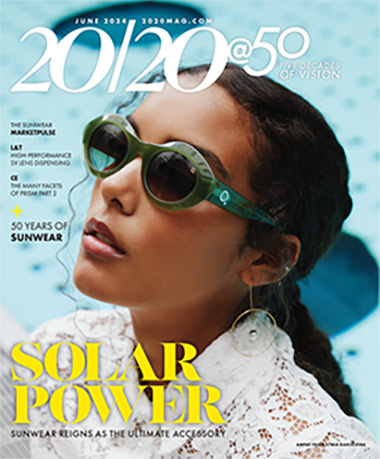
By Johnna Dukes, ABOC
Those of us who dispense eyewear have our favorite memories of dispensing. I remember how much it changed my perspective of the profession when I was first able to deliver clear vision to someone who had never experienced it before. What a powerful memory. How often do you get to deliver a “wow” visual experience in the context of your everyday working life? Do you wish it were more often? I would like to share a product experience that brought that feeling back to me, and believe it or not, it happened with a single vision lens.
THE ‘WHY’
Before we get into the “what” of this conversation, let’s start with the “why.” Think about the demographic of prescription most likely to take their Rx and shop it around. In my experience, it is a single vision wearer. And who could blame them? Your office might have the best frames around, and your office might have the most knowledgeable opticians who can make those gorgeous frames fit the patient perfectly. However, even with the wonderful frame, the visual experience the single vision wearer is having in their spectacles is likely somewhat similar to what they had before unless you’re using free-form personalized lenses and accurate position of wear measurements. Statistically speaking, most dispensers are not.
According to Jobson Optical Research’s 2024 Premium Lens MarketPulse Survey published in the May edition of 20/20, 29 percent of retailers who responded said less than 3 percent of single vision Rxs sold are digitally enhanced, and over half of retailers (56 percent) said less than 3 percent of single vision digitally enhanced lenses use actual position of wear measurements done in office. That’s interesting, especially when you consider that according to the same survey, over half (58 percent) of retailers said that customized or personalized progressive lenses made up a greater proportion of their total lens sales in 2023 than they had versus three years ago. My read of these statistics indicate that we are more willing to utilize customized or personalized progressive lenses than customized or personalized single vision lenses.
Think about this from the single vision wearer’s perspective. In my experience, many single vision wearers, especially ones who primarily wear contact lenses, tend to think of their eyewear as a backup, or as a utility or necessity. It’s not something they are terribly excited to purchase or wear, certainly not something they want to spend much money on. Some even look at their eyewear as a commodity. And what do you do when shopping for commodities? You believe all other factors to be the same, so you compare price only. But what if we could shift that perception a bit. What could be gained by changing the visual experience for this wearer?
It could change many things for your practice and for your patients. But most importantly, it can bring about a return of your excitement to dispense glasses. (Remember that feeling of delivering clear vision to someone who have not experienced it before and getting to have a similar feeling more regularly.) I know that sounds like a hefty proposition, but I’ve seen firsthand that it can really make a difference, and setting your practice apart from others because of your ability to enhance your patient’s visual experience is never a bad place to be! If you’re having fun, it’s hard for your patients not to. And couldn’t we all use a little more fun?
THE ‘WHAT’
Personalized and customized single vision lenses are the vehicle that can deliver an easily distinguishable, superior visual experience for the single vision wearer. Fortunately, there are several great ones to choose from on the market today. In fact, in some of my recent dispensing, I had patients describe the vision they experience with some of these lens designs to be much more similar to what they experience with their contact lenses, only in a spectacle lens.
THE ‘HOW’
If you think about it, there is a world of difference between the vision a patient experiences through a phoropter in a darkened exam lane and in a traditionally surfaced lens mounted in a frame placed on the patient’s face. For starters, the phoropter places the lens perpendicular to the patient’s visual axis with no face form and no pantoscopic tilt. Additionally, lenses in a phoropter are fairly small, giving no perception of what the peripheral distortion might be because there simply isn’t much of it. Of course, that’s not at all the case when looking through a traditionally surfaced lens mounted in a frame.
Traditionally surfaced single vision lenses correct vision in the optical center of the lens, and depending on the prescription, that can leave a good bit of distortion in the periphery of the lens. Most single vision wearers who have significant corrections have learned that they must turn their head and point their nose at what they are looking at in order to utilize the part of the lens that has the most clarity (optical center). But when they turn their eyes in any meridian away from the optical center, the patient experiences aberrations such as power error and astigmatic error which cause the lack of focus.
Hoya Vision Care recently released the MySV lens that incorporates some innovative design features that help to create a “wow” visual experience for the wearer. Hoya’s marketing material states: “MySV lens is an individually optimized and compensated lens designed to correct lens optical errors due to the oblique angles resulting from off-axis gaze directions. The clarity experienced is especially apparent with higher powers and cylinder correction. Besides the benefit of compensating the lenses for frame fit based on position of wear measurements, MySV lenses also optimize the lens surface to accommodate eye rotations resulting in aberrations. MySV free-form design adjusts the lens surface to account for frame fit metrics, biometrics (mono PD), Rx and base curve, and refractive index resulting in thinner precision lenses with 360 degrees of comfort by utilizing a cutting-edge lens design that uses an advanced algorithm to compute the optimal lens surface needed to correct for all angles as the eyes rotate off axis.”
Some of the unique features to these lenses include optimized free-form back of the lens surfacing, utilization of aspheric and atoric curves, unique design taking into account right and left eye wearing parameters, and evaluation with patented binocular eye models, which establishes how the lens design needs to be modified in order to create perfectly overlapping images from each eye for the brain to produce the best possible visual experience.
Several other lens companies also offer single vision lenses in this category. For example, IOT’s Endless Single Vision Lens utilizes the Digital Ray-Path 2 technology to optimize vision at every distance and direction of gaze including near vision, and this lens also takes into account the patient’s natural accommodation into the calculations for reducing oblique aberrations. Consider this lens for high prescriptions and wrap lenses, because the compensations yield a consistent power distribution regardless of blank size or base curve.
IOT also offers the Endless Drive Single Vision lens which addresses the issue of night myopia and is designed to be worn all day. It’s recommended for patients who have issues driving at night.
IOT’s Endless Anti-Fatigue single vision lens is another option for those in need of a plus power boost at the bottom of the lens to create more relaxed vision with less accommodative effort.
The ClearView SV lens from Zeiss includes point-by-point free-form optimization using 700 parameters in their single vision lens platform and have even been able to incorporate this technology into a finished stock single vision lens. Zeiss’ simulations show the ClearView SV lenses provide on average three times larger zones of visual clarity when compared to previous aspheric single vision lenses. Zeiss uses CORE technology which calculates the differences in the center of rotation of the eyeball based on whether the patient is myopic or hyperopic and incorporates this information into the design algorithm.
Zeiss recently introduced the SmartLife Young SV lens which takes into account age-specific factors, position of wear and pupil size. The result is a lens design that offers a 60 percent wider field of clear viewing for handheld devices when compared to conventional single vision lenses, according to Zeiss.
Part of what I find innovative about the Zeiss platform is that they factor in pupil size changes due to age and accommodation, as well as how changes in facial properties due to age will affect the facial plane and builds these metrics into their compensations, again creating lenses with incredibly comfortable vision for the wearer.
Another single vision lens to consider is Essilor’s Eyezen Start. (A version of this lens designed for wearers ages 8 to 12 is called Eyezen Kids, which considers the unique fit needs of children, i.e., that kids’ arms are shorter, resulting in a near focal length that would be closer than that of an adult.) Eyezen Start is unique as it optimizes the single vision lens for both the horizontal meridian (giving an incredibly wide distance vista) as well as taking into account that when a wearer looks down, they are likely focusing not at distance, but at about 16 inches and compensating for the decreased focal distance to create a comfortable near vision viewing experience at the bottom of the lens. All of Essilor’s Eyezen lenses utilize W.A.V.E. technology which aims to create sharper vision by reducing aberrations across the lens surface.
Essilor also offers Eyezen+, an enhanced single vision lens designed to help reduce visual fatigue at near by adding a plus power shift at the bottom of the lens. Essilor has created this lens to make accommodation at near more comfortable for the wearer and have four different power shift levels to best serve their patients. Essilor’s studies show eyeglass wearers prefer lenses with Eyezen+ lenses to traditional single vision lenses. These enhanced single vision lenses can really be a game changer for someone who is a frequent near vision user, and this category has wide ranging benefits to a multitude of patients. (It is worth noting, however, that any lens with a power shift for near, sometimes referred to as enhanced single vision lenses, are classified differently in a few states as to whether they are considered a single vision lens, so best practice might be to check with the prescriber prior to dispensing these lenses if you reside in one of these states.)
BE A DIFFERENCE MAKER
The biggest reason to consider use of a customized single vision lens is to show your patient that they can have a run of the mill single vision lens experience somewhere else, or they can have a superior visual experience with you. These lenses leave no doubt that they are not your ordinary single vision lenses, and that your practice is not an ordinary practice but one who cares about delivering the best vision and the best visual experience for their patients. It shows your patient that their eyewear is not a commodity, but a fully customized optical device that has been designed with their optimal vision in mind. I have to say, that wow moment when you dispense these lenses is incredibly fun. It’s the most fun I’ve been able to have dispensing in some time. And who wouldn’t want to have a little more fun in their day?
Think about how this experience for a single vision wearer can create a long-lasting trust that will take them into their next number of years that will eventually include their presbyopic journey. Creating a personalized experience for a single vision wearer can likely create a trust that lasts a lifetime for your patients. ■












